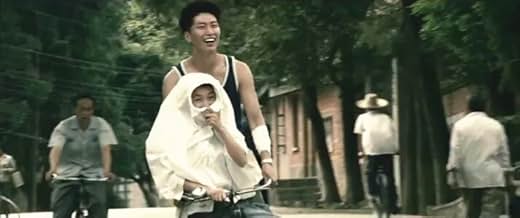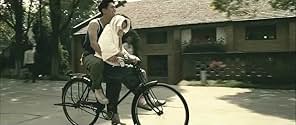IMDb RATING
7.1/10
3.9K
YOUR RATING
Romance sparks between a young woman and a young man from different economic backgrounds during China's Cultural Revolution of the 1960s and '70s.Romance sparks between a young woman and a young man from different economic backgrounds during China's Cultural Revolution of the 1960s and '70s.Romance sparks between a young woman and a young man from different economic backgrounds during China's Cultural Revolution of the 1960s and '70s.
- Awards
- 10 wins & 12 nominations total
Jinsong Wang
- Director Li (Li Zhuren)
- (as Qi Ke)
Liping Lü
- Wei's Mother (Weihong Muqin)
- (as Liping Lv)
Storyline
Did you know
Featured review
In some restaurants, the chef goes out of his way to create complex dishes, with intricate combinations of tastes, colours and cooking styles. Others specialize in simple dishes, that stand out because of the quality of the ingredients. A simple pasta pesto can be a treat if it's made with the best olive oil, freshly grated parmesan and homegrown basil.
Under the Hawthorn Tree is like such a simple, but delicious dish. It's a straightforward story of a forbidden love, told in a basic way, without many frills. But Zhang Yimou is such a craftsman, that he doesn't need much to make a great movie.
The story is set during the cultural revolution, a period of ruthless oppression by the communist regime. The young girl Jing is being watched by the authorities because her father was a 'reactionary' and she risks losing her job as a teacher. During a trip to the countryside she falls in love with Sun. Her mother is afraid the affair will harm Jing's future career, and she forbids the two lovers to see each other.
Zhang Yimou tells the story in a simple way, focusing on the two lovers. He uses title cards to make the story go forward, a smart move because it prevents the script from having to explain too much. In this way, Zhang concentrates on the story of Jing and her lover Sun, and nothing else.
China in the seventies was a country where people led simple lives. Zhang emphasizes this by using simple props, like a goldfish key-chain made of yarn and beads, or a metal bowl with a special decoration. The hawthorn tree from the title also has a symbolic meaning, and in the very last image of the movie, when we see the tree blossoming, Zhang has an unexpected surprise that will make you smile.
The acting is wonderful. The two leads tell just as much with their eyes, their laughs and their expressions as with their words. Take for example the scene where Jing gives her goldfish to Sun, and the camera lingers on their faces to show us how they feel. Wonderful film making.
With this film, Zhang Yimou returns to his earlier style of film making, telling stories about the daily life in China. Under the Hawthorn Tree has more in common with his lesser-known films like Not One Less or The Road Home, than with his visually more spectacular films like The House of Flying Daggers, or even Raise The Red Lantern.
Some people may be disappointed by the slow story, in which nothing spectacular happens. But some of history's greatest film classics are slow and subtle. In a way, Under the Hawthorn Tree made me think of David Lean's classic Brief Encounter, another story about a forbidden love, that stands out because of the impeccable directing and acting.
Under the Hawthorn Tree is like such a simple, but delicious dish. It's a straightforward story of a forbidden love, told in a basic way, without many frills. But Zhang Yimou is such a craftsman, that he doesn't need much to make a great movie.
The story is set during the cultural revolution, a period of ruthless oppression by the communist regime. The young girl Jing is being watched by the authorities because her father was a 'reactionary' and she risks losing her job as a teacher. During a trip to the countryside she falls in love with Sun. Her mother is afraid the affair will harm Jing's future career, and she forbids the two lovers to see each other.
Zhang Yimou tells the story in a simple way, focusing on the two lovers. He uses title cards to make the story go forward, a smart move because it prevents the script from having to explain too much. In this way, Zhang concentrates on the story of Jing and her lover Sun, and nothing else.
China in the seventies was a country where people led simple lives. Zhang emphasizes this by using simple props, like a goldfish key-chain made of yarn and beads, or a metal bowl with a special decoration. The hawthorn tree from the title also has a symbolic meaning, and in the very last image of the movie, when we see the tree blossoming, Zhang has an unexpected surprise that will make you smile.
The acting is wonderful. The two leads tell just as much with their eyes, their laughs and their expressions as with their words. Take for example the scene where Jing gives her goldfish to Sun, and the camera lingers on their faces to show us how they feel. Wonderful film making.
With this film, Zhang Yimou returns to his earlier style of film making, telling stories about the daily life in China. Under the Hawthorn Tree has more in common with his lesser-known films like Not One Less or The Road Home, than with his visually more spectacular films like The House of Flying Daggers, or even Raise The Red Lantern.
Some people may be disappointed by the slow story, in which nothing spectacular happens. But some of history's greatest film classics are slow and subtle. In a way, Under the Hawthorn Tree made me think of David Lean's classic Brief Encounter, another story about a forbidden love, that stands out because of the impeccable directing and acting.
- How long is Under the Hawthorn Tree?Powered by Alexa
Details
- Release date
- Country of origin
- Official site
- Language
- Also known as
- Chuyện Tình Cây Táo Gai
- Production companies
- See more company credits at IMDbPro
Box office
- Gross worldwide
- $23,004,431
- Runtime1 hour 54 minutes
- Color
- Sound mix
- Aspect ratio
- 2.35 : 1
Contribute to this page
Suggest an edit or add missing content
























